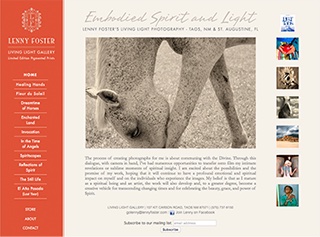Where We Stand
“This series has been influenced by my relocation to Saint Augustine, Florida and, more precisely, moving into the historic township of Lincolnville. Upon arriving in Saint Augustine I discovered a deep history, largely unknown to the public at large, about the history of African Americans in our country. I learned a hidden history of my own African American heritage.
Unknowningly, I found myself in the center and early focus of the Civil Rights movement. I discovered a deep, rich, powerful history of the first Africans and African American history in Saint Augustine. In the early 1960s the community was beseigned by the Klu Klux Khan and requested help from the Southern Christian Leadership Conference. The historic community of Lincolnville played a huge role, largely unrecognized nationally, in shaping the development of the Civil Rights movement across the country.
From Fort Mose, the first settlement for freed Africans, to the recent first African American candidate for the Governor of Florida, I aim to use a unique perspective of photographic storytelling by placing shoes, representing individuals and groups, in historical places throughout the city of Saint Augustine. Examples of such imagery would be: the plaza market where slaves were sold and a compound where the emancipation proclamation was read to the slaves. Lincolnville has many inspiring stories including those surrounding the places where Martin Luther King Jr. marched, preached, protested, slept and was arrested. Others arrested at that time include Andrew Young and the local activist Dr. Robert Hayling and sixteen Rabbis that came from different parts of the country in support of the Civil Rights Movement. The Woolworths lunch counter where “The Saint Augustine Four” were arrested because of their “Sit-in” is still there. The series will also honor the bravery of the young people involved in the “Swim-in”, integrating a segregated pool and having the owner pour acid in the pool to get them out. Those actions, along with the national coverage they generated, helped bring about the passage of Civil Rights Bill.
There are many stories to tell about that history as well as about the artists, writers and entertainers, such as Ray Charles, Ella Fitzgerald, and Zora Neale Hurston who are connected to the local community. All walks of life will be represented, from school children that were the first in the country to be bused to integrate schools, to those involved in the heated debate over Confederate statues, to other contemporary examples of African American role models in this community.
The decision to use shoes, as the vehicle for storytelling came as a result of the controversy surrounding the kneeling of professional athletes protesting racism in America. The imagery and text aim to show who we are and where we have been as a people in this area. This history is vast and rich and we have stood, sat and knelt for many a high and honorable cause, not to mention, the struggle for everyday existence.
As the awareness of this history dawned on me it has become a focus of my work allowing me to combine my fine art photography with a historic and social awareness of the continuing struggle for freedom and recognition by the people who are my ancestors, my heritage. I feel honored to be able to share this history, through my work, with a broader public." –Lenny Foster

